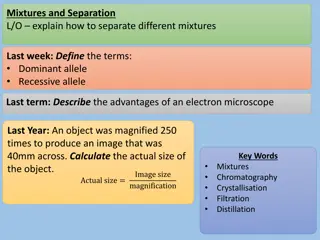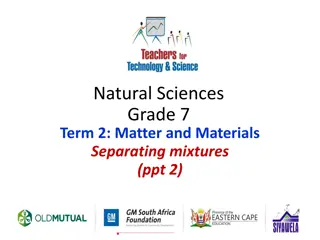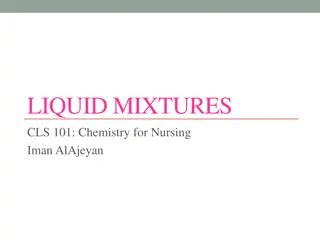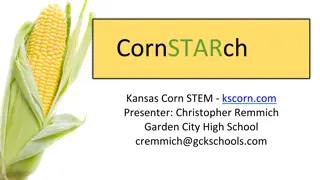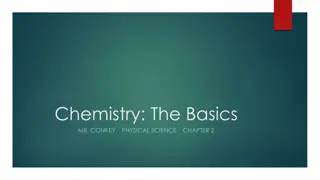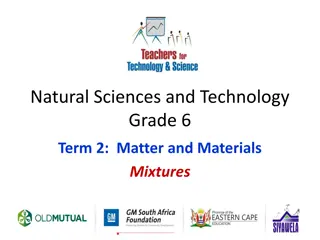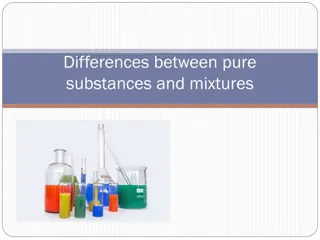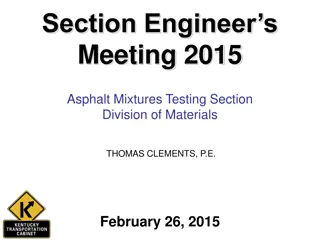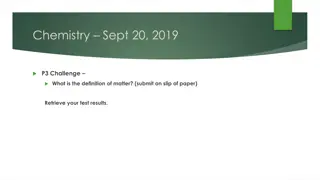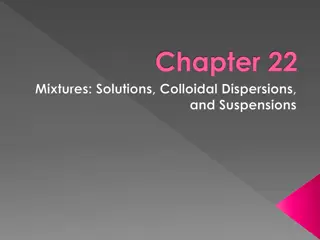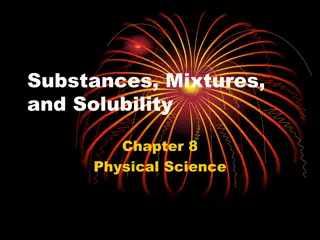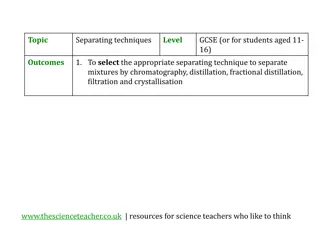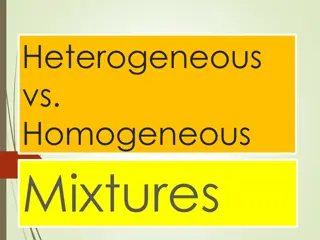Year 7 Science Curriculum Overview: Particle Model, Separating Mixtures, Cells
Understand scientific concepts, techniques, and procedures through topics such as particle model, separating mixtures, and cells. Learn to apply knowledge, conduct scientific inquiries, and analyze information to develop experimental procedures. Key skills include techniques for separating mixtures and observing cells under a microscope.
Download Presentation

Please find below an Image/Link to download the presentation.
The content on the website is provided AS IS for your information and personal use only. It may not be sold, licensed, or shared on other websites without obtaining consent from the author. Download presentation by click this link. If you encounter any issues during the download, it is possible that the publisher has removed the file from their server.
E N D
Presentation Transcript
Science Faculty curriculum overview Science Faculty curriculum overview Year 7 (KS3) Year 7 (KS3) Topic 1- Particle Model 2- Separating Mixtures 3- Cells Length of topic (in weeks) 2 Weeks 2 Weeks 2 Weeks AO1: Demonstrate knowledge and understanding of: Scientific ideas Scientific techniques and procedures AO2: Apply knowledge and understanding of: Scientific ideas Scientific enquiry, techniques and procedures AO3: Analyse information and ideas to: Develop and improve experimental procedures (solve- theories) AO1: Demonstrate knowledge and understanding of: Scientific ideas Scientific techniques and procedures AO2: Apply knowledge and understanding of: Scientific ideas Scientific enquiry, techniques and procedures AO3: Analyse information and ideas to: Develop and improve experimental procedures (solve- hazards) AO1: Demonstrate knowledge and understanding of: Scientific ideas Scientific techniques and procedures AO2: Apply knowledge and understanding of: Scientific ideas Scientific enquiry, techniques and procedures AO3: Analyse information and ideas to: Develop and improve experimental procedures (solve-hazards) Links to specification Particle models-solve (Theories) Recall 5 Self-evaluation sheets Separating rock salt- Solve (Hazards) (AO3c) Recall 5 Self-evaluation sheets Microscopy - Solve (Hazards) Recall 5 Self-evaluation sheets Assessment Task(s) Properties of solids, liquids and gases can be described in terms of particles in motion but with differences in the arrangement and movement of these same particles: closely spaced and vibrating (solid), in random motion but in contact (liquid), or in random motion and widely spaced (gas). Observations where substances change temperature or state can be described in terms of particles gaining or losing energy. A pure substance consists of only one type of element or compound and has a fixed melting and boiling point. Mixtures may be separated due to differences in their physical properties. The method chosen to separate a mixture depends on which physical properties of the individual substances are different. Multicellular organisms are composed of cells which are organised into tissues, organs and systems to carry out life processes. There are many types of cell. Each has a different structure or feature so it can do a specific job. Key Knowledge Understand that scientific methods and theories develop as earlier explanations are modified to take account of new evidence and ideas, together with the importance of publishing results and peer review Use techniques to separate mixtures. Separate ingredients from mixtures using appropriate techniques such as evaporation, filtration, chromatography and magnets. Work out the amount of salt in salt water - express as percentage Use a light microscope to observe and draw cells. Obtain and record a clearly focused image of a microscopic object. Work out the length of a plant cell - give results in nm, um and mm. Express in normal and standard form. Key Skills
Science Faculty curriculum overview Science Faculty curriculum overview Year 7 (KS3) Year 7 (KS3) Topic 4- Movement 5- Energy Transfer 6- Earth Structure Length of topic (in weeks) 3 Weeks 4 Weeks 2 Weeks AO1: Demonstrate knowledge and understanding of: Scientific ideas Scientific techniques and procedures AO2: Apply knowledge and understanding of: Scientific ideas Scientific enquiry, techniques and procedures AO3: Analyse information and ideas to: Interpret and evaluate (analyse) AO1: Demonstrate knowledge and understanding of: Scientific ideas Scientific techniques and procedures AO2: Apply knowledge and understanding of: Scientific ideas Scientific enquiry, techniques and procedures AO3: Analyse information and ideas to: Make judgements and draw conclusions (enquire) AO1: Demonstrate knowledge and understanding of: Scientific ideas Scientific techniques and procedures AO2: Apply knowledge and understanding of: Scientific ideas Scientific enquiry, techniques and procedures AO3: Analyse information and ideas to: Interpret and evaluate (analyse) Links to specification Muscle Investigation -Analyse (AO3a) Self-evaluation sheets Burning foods- Enquire(AO3b) Recall 5 Self-evaluation sheets Cooling of Salol-Analyse (AO3a) Recall 5 End of term test (AO2) Self-evaluation sheets Assessment Task(s) The parts of the human skeleton work as a system for support, protection, movement and the production of new blood cells. Antagonistic pairs of muscles create movement when one contracts and the other relaxes. We can describe how jobs get done using an energy model where energy is transferred from one store at the start to another at the end. When energy is transferred, the total is conserved, but some energy is dissipated, reducing the useful energy. Sedimentary, igneous and metamorphic rocks can be inter converted over millions of years through weathering and erosion, heat and pressure, and melting and cooling. Key Knowledge Carry out practical procedures using instructions without guidance and in a calm fashion with due regard to the safety of others. Collect data from throwing a ball and measuring arm length. Draw conclusions, Communicate ideas Construct explanations when investigating the energy in different foods Observe and investigate how the rate of cooling affects crystal formation. Use models to represent rock formation. Key Skills
Science Faculty curriculum overview Science Faculty curriculum overview Year 7 (KS3) Year 7 (KS3) Topic 7- Acids and Alkalis 8- Speed 9-Current Length of topic (in weeks) 3 Weeks 3 Weeks 1 week AO1: Demonstrate knowledge and understanding of: Scientific ideas Scientific techniques and procedures AO2: Apply knowledge and understanding of: Scientific ideas Scientific enquiry,techniques and procedures AO3: Analyse information and ideas to: Make judgements and draw conclusions (enquire) AO1: Demonstrate knowledge and understanding of: Scientific ideas Scientific techniques and procedures AO2: Apply knowledge and understanding of: Scientific ideas Scientific enquiry, techniques and procedures AO3: Analyse information and ideas to: Interpret and evaluate (analyse) AO1: Demonstrate knowledge and understanding of: Scientific ideas Scientific techniques and procedures AO2: Apply knowledge and understanding of: Scientific ideas Scientific enquiry, techniques and procedures AO3: Analyse information and ideas to: Interpret and evaluate (analyse) Links to specification Neutralisation- Enquire (AO3b) Recall 5 Self-evaluation sheets Investigating speed- (AO3a- analyse) Recall 5 Self-evaluation sheets Investigating current- (AO3a- analyse) Recall 5 Self-evaluation sheets Assessment Task(s) The pH of a solution depends on the strength of the acid: strong acids have lower pH values than weak acids. Mixing an acid and alkali produces a chemical reaction, neutralisation, forming a chemical called a salt and water. Speed: How much distance is covered in how much time. Average speed: The overall distance travelled divided by overall time for a journey. Relative motion: Different observers judge speeds differently if they are in motion too, so an object s speed is relative to the observer s speed. Acceleration: How quickly speed increases or decreases Current is a movement of electrons and is the same everywhere in a series circuit. Current divides between loops in a parallel circuit, combines when loops meet, lights up bulbs and makes components work Key Knowledge Observe and investigate a range of chemical reactions using equipment appropriately. Measure changes in the pH of solutions using indicators Measure the speed of a moving object using appropriate equipment Represent and interpret a range of simple circuit diagrams using appropriate symbols. Build electrical circuits using various components and measure current using an ammeter Key Skills
Science Faculty curriculum overview Science Faculty curriculum overview Year 7 (KS3) Year 7 (KS3) Topic 10- Voltage and Resistance 11- Variation Length of topic (in weeks) 2 Weeks 4 Weeks AO1: Demonstrate knowledge and understanding of: Scientific ideas Scientific techniques and procedures AO2: Apply knowledge and understanding of: Scientific ideas Scientific enquiry, techniques and procedures AO3: Analyse information and ideas to: Make judgements and draw conclusions (enquire) AO1: Demonstrate knowledge and understanding of: Scientific ideas Scientific techniques and procedures AO2: Apply knowledge and understanding of: Scientific ideas Scientific enquiry, techniques and procedures AO3: Analyse information and ideas to: Develop and improve experimental procedures (solve- theories) Links to specification Resistance in a wire-Enquire (AO3b) Recall 5 Self-evaluation sheets Self Evaluation Sheets Solve (theories) (AO3c)- Evolution Recall 5 End of term test (AO2) Assessment Task(s) Around a charged object, the electric field affects other charged objects, causing them to be attracted or repelled. The field strength decreases with distance. We can model voltage as an electrical push from the battery, or the amount of energy per unit of charge transferred through the electrical pathway. In a series circuit, voltage is shared between each component. In a parallel circuit, voltage is the same across each loop. Components with resistance reduce the current flowing and shift energy to the surroundings. There is variation between individuals of the same species. Some variation is inherited, some is caused by the environment and some is a combination. Variation between individuals is important for the survival of a species, helping it to avoid extinction in an always changing environment. Key Knowledge Represent and interpret a range of simple circuit diagrams using appropriate symbols. Build electrical circuits using various components and measure current and voltage using an ammeter and voltmeter. Collect data on continuous and discontinuous variation and decide how to present data appropriately. Key Skills
Science Faculty curriculum overview Science Faculty curriculum overview Year 7 (KS3) Year 7 (KS3) Topic 12- Sound 13- Interdependence Length of topic (in weeks) 3 Weeks 4 Weeks AO1: Demonstrate knowledge and understanding of: Scientific ideas Scientific techniques and procedures AO2: Apply knowledge and understanding of: Scientific ideas Scientific enquiry, techniques and procedures AO3: Analyse information and ideas to: Make judgements and draw conclusions (enquire) AO1: Demonstrate knowledge and understanding of: Scientific ideas Scientific techniques and procedures AO2: Apply knowledge and understanding of: Scientific ideas Scientific enquiry, techniques and procedures AO3: Analyse information and ideas to: Interpret and evaluate (analyse) Links to specification Calculating speed of sound- Enquire-(AO3b) Population graphs-Analyse (AO3a) Recall 5 End of Year test (AO2) Assessment Task(s) Sound consists of vibrations which travel as a longitudinal wave through substances. The denser the medium, the faster sound travels. The greater the amplitude of the waveform, the louder the sound. The greater the frequency (and therefore the shorter the wavelength), the higher the pitch. Organisms in a food web (decomposers, producers and consumers) depend on each other for nutrients. So, a change in one population leads to changes in others. The population of a species is affected by the number of its predators and prey, disease, pollution and competition between individuals for limited resources such as water and nutrients. Key Knowledge Represent different sounds in graph form. Represent changes to a population size in graph form. Interpret population size data relate to changes in the environment. Key Skills
Science Faculty curriculum overview Science Faculty curriculum overview Year 8 (KS3) Year 8 (KS3) Topic 1- Elements 2- Metals and non metals 3- Types of reactions 4- Digestion 2 Weeks Length of topic (in weeks) 3 Weeks 3 Weeks 3 Weeks AO1: Demonstrate knowledge and understanding of: Scientific ideas Scientific techniques and procedures AO2: Apply knowledge and understanding of: Scientific ideas Scientific enquiry, techniques and procedures AO3: Analyse information and ideas to: Interpret and evaluate (analyse) AO1: Demonstrate knowledge and understanding of: Scientific ideas Scientific techniques and procedures AO2: Apply knowledge and understanding of: Scientific ideas Scientific enquiry, techniques and procedures AO3: Analyse information and ideas to: Interpret and evaluate (analyse) AO1: Demonstrate knowledge and understanding of: Scientific ideas Scientific techniques and procedures AO2: Apply knowledge and understanding of: Scientific ideas Scientific enquiry, techniques and procedures AO3: Analyse information and ideas to: Interpret and evaluate (analyse) AO1: Demonstrate knowledge and understanding of: Scientific ideas Scientific techniques and procedures AO2: Apply knowledge and understanding of: Scientific ideas Scientific enquiry, techniques and procedures AO3: Analyse information and ideas to: Make judgements and draw conclusions (enquire) Links to specification Exothermic and endothermic reactions Analyse (AO3a) Recall 5 Self-evaluation sheets Assessment Task(s) Comparing how elements react Analyse- (AO3b) Recall 5 Self-evaluation sheets Displacement reactions- Analyse (AO3a) Recall 5 Self-evaluation sheets Food tests-Enquire- (AO3b) Recall 5 Self-evaluation sheets Most substances are not pure elements, but compounds or mixtures containing atoms of different elements. They have different properties to the elements they contain. Metals and non-metals react with oxygen to form oxides which are either bases or acids. Metals can be arranged as a reactivity series in order of how readily they react with other substances. Some metals react with acids to produce salts and hydrogen. Combustion is a reaction with oxygen in which energy is transferred to the surroundings as heat and light. Thermal decomposition is a reaction where a single reactant is broken down into simpler products by heating. Chemical changes can be described by a model where atoms and molecules in reactants rearrange to make the products and the total number of atoms is conserved. The body needs a balanced diet with carbohydrates, lipids, proteins, vitamins, minerals, dietary fibre and water, for its cells energy, growth and maintenance. Organs of the digestive system are adapted to break large food molecules into small ones which can travel in the blood to cells and are used for life processes. Key Knowledge Use particle diagrams to classify a substance as an element, mixture or compound and as molecules or atoms. Name simple compounds using rules: change non-metal to ide; mono, di, tri prefixes; and symbols of hydroxide, nitrate, sulfate and carbonate. Analyse patterns Discuss limitations Draw conclusions Present data Communicate ideas Construct explanations Estimate risks Examine consequences Write word equations from information about chemical reactions. Use appropriate units for area measurements. Calculate area for a variety of shapes, including rectangles and cuboids. Key Skills
Science Faculty curriculum overview Science Faculty curriculum overview Year 8 (KS3) Year 8 (KS3) Topic 5- Breathing 6- Light 7- Plant Reproduction 3 Weeks Length of topic (in weeks) 3 Weeks 3 Weeks AO1: Demonstrate knowledge and understanding of: Scientific ideas Scientific techniques and procedures AO2: Apply knowledge and understanding of: Scientific ideas Scientific enquiry, techniques and procedures AO3: Analyse information and ideas to: draw conclusions (enquire) Develop and improve experimental procedures (solve- Hazards) AO1: Demonstrate knowledge and understanding of: Scientific ideas Scientific techniques and procedures AO2: Apply knowledge and understanding of: Scientific ideas Scientific enquiry, techniques and procedures AO3: Analyse information and ideas to: Make judgements and draw conclusions (enquire) AO1: Demonstrate knowledge and understanding of: Scientific ideas Scientific techniques and procedures AO2: Apply knowledge and understanding of: Scientific ideas Scientific enquiry, techniques and procedures AO3: Analyse information and ideas to: Develop and improve experimental procedures (solve-theories) Links to specification Exercise and breathing rate- Solve (hazards) (AO3c) Recall 5 Self-evaluation sheets End of term test (AO2) Assessment Task(s) Refraction and reflection-Enquire- (AO3b) Recall 5 Self-evaluation sheets Plant dissection-Solve (theories) (AO3c) Recall 5 Self-evaluation sheets In gas exchange, oxygen and carbon dioxide move between alveoli and the blood. Oxygen is transported to cells for aerobic respiration and carbon dioxide, a waste product of respiration, is removed from the body. Breathing occurs through the action of muscles in the ribcage and diaphragm. The amount of oxygen required by body cells determines the rate of breathing Year 7- particles- diffusion When a light ray meets a different medium, some of it is absorbed and some reflected. For a mirror, the angle of incidence equals the angle of reflection. The ray model can describe the formation of an image in a mirror and how objects appear different colours. When light enters a denser medium it bends towards the normal; when it enters a less dense medium it bends away from the normal. Refraction through lenses and prisms can be described using a ray diagram as a model. Plants have adaptations to disperse seeds using wind, water or animals. Plants reproduce sexually to produce seeds, which are formed following fertilisation in the ovary Key Knowledge Identify the ranges of readings in data. Explain why data with a small range is of good quality. Calculate means and explain their use. Identify anomalous results in data. Construct ray diagrams to show how light reflects off mirrors, forms images and refracts. Use appropriate units for area measurements. Calculate areas for squares and rectangles. Use a sample to calculate an estimate of population size. Key Skills
Science Faculty curriculum overview Science Faculty curriculum overview Year 8 (KS3) Year 8 (KS3) Topic 9- Contact Forces 10- Universe 8- Gravity Length of topic (in weeks) 3 Weeks 3 Weeks 2 Week AO1: Demonstrate knowledge and understanding of: Scientific ideas Scientific techniques and procedures AO2: Apply knowledge and understanding of: Scientific ideas Scientific enquiry, techniques and procedures AO3: Analyse information and ideas to: Develop and improve experimental procedures (solve- theories) AO1: Demonstrate knowledge and understanding of: Scientific ideas Scientific techniques and procedures AO2: Apply knowledge and understanding of: Scientific ideas Scientific enquiry, techniques and procedures AO3: Analyse information and ideas to: AO1: Demonstrate knowledge and understanding of: Scientific ideas Scientific techniques and procedures AO2: Apply knowledge and understanding of: Scientific ideas Scientific enquiry, techniques and procedures AO3: Analyse information and ideas to: Develop and improve experimental procedures (solve- theories Links to specification Make judgements and draw conclusions (enquire) Elastic limit -Enquire- (AO3b) Recall 5 Self-evaluation sheets Diagrams/models of the universe solve (theories)- AO3c) Recall 5 Self-evaluation sheets End of term test (AO2) Assessment Task(s) Gravity (Solve- theories) (AO3c) Recall 5 Self-evaluation sheets Mass and weight are different but related. Mass is a property of the object; weight depends upon mass but also on gravitational field strength. Every object exerts a gravitational force on every other object. The force increases with mass and decreases with distance. Gravity holds planets and moons in orbit around larger bodies. When the resultant force on an object is zero, it is in equilibrium and does not move, or remains at constant speed in a straight line. One effect of a force is to change an object s form, causing it to be stretched or compressed. In some materials, the change is proportional to the force applied. Year 7- speed- contact and non contact forces, forces and motion The solar system can be modelled as planets rotating on tilted axes while orbiting the Sun, moons orbiting planets and sunlight spreading out and being reflected. This explains day and year length, seasons and the visibility of objects from Earth. Our solar system is a tiny part of a galaxy, one of many billions in the Universe. Light takes minutes to reach Earth from the Sun, four years from our nearest star and billions of years from other galaxies. Keywords Key Knowledge Use the formula: weight (N) = mass (kg) x gravitational field strength (N/kg). Sketch the forces acting on an object, and label their size and direction. Using ratios to compare quantities. Writing one number as a fraction of another and converting fractions to decimals. Substituting values into simple formulae and solving resulting equations. Drawing line graphs and scatter graphs, and using these to draw conclusions. Key Skills
Science Faculty curriculum overview Science Faculty curriculum overview Year 8 (KS3) Year 8 (KS3) Topic 11- Human Reproduction 12- Energy Costs 13- Magnestism Length of topic (in weeks) 3 Weeks 2 Weeks 2 Weeks AO1: Demonstrate knowledge and understanding of: Scientific ideas Scientific techniques and procedures AO2: Apply knowledge and understanding of: Scientific ideas Scientific enquiry, techniques and procedures AO3: Analyse information and ideas to: Interpret and evaluate (analyse) AO1: Demonstrate knowledge and understanding of: Scientific ideas Scientific techniques and procedures AO2: Apply knowledge and understanding of: Scientific ideas Scientific enquiry, techniques and procedures AO3: Analyse information and ideas to: Develop and improve experimental procedures (solve- hazards) AO1: Demonstrate knowledge and understanding of: Scientific ideas Scientific techniques and procedures AO2: Apply knowledge and understanding of: Scientific ideas Scientific enquiry, techniques and procedures AO3: Analyse information and ideas to: Make judgements and draw conclusions (enquire) Links to specification Gestation periods Analyse (AO3a) Recall 5 Self-evaluation sheets Comparing effeciency and calculating efficiency Solve (Hazards) (AO3c) Recall 5 Self-evaluation sheets Magnestic fields around different types of magnets Enquire- (AO3b) Recall 5 Self-evaluation sheets End of Year test (AO2) Assessment Task(s) The menstrual cycle prepares the female for pregnancy and stops if the egg is fertilised by a sperm. The developing foetus relies on the mother to provide it with oxygen and nutrients, to remove waste and protect it against harmful substances. We pay for our domestic electricity usage based on the amount of energy transferred. Electricity is generated by a combination of resources which each have advantages and disadvantages. Calculate the cost of home energy usage, using the formula: cost = power (kW ) x time (hours) x price (per kWh) Magnetic materials, electromagnets and the Earth create magnetic fields which can be described by drawing field lines to show the strength and direction. The stronger the magnet, and the smaller the distance from it, the greater the force a magnetic object in the field experiences. Key Knowledge An understanding of number, size and scale and the quantitative relationship between units. Using estimations and explaining when they should be used. substituting values in simple formulae and solving resulting equations Present data Communicate ideas Construct explanations Key Skills
Science Faculty curriculum overview Science Faculty curriculum overview Year 9 (KS3) Year 9 (KS3) 1.Inheritance 2.Periodic Table 3.Electromagnetism Topic Length of topic 3 Weeks 3 Weeks 2 Weeks AO1: Demonstrate knowledge and understanding of: Scientific ideas Scientific techniques and procedures AO2: Apply knowledge and understanding of: Scientific ideas Scientific techniques and procedures AO3: Analyse information and ideas to: Develop and improve experimental procedures (solve- theories) AO1: Demonstrate knowledge and understanding of: Scientific ideas Scientific techniques and procedures AO2: Apply knowledge and understanding of: Scientific ideas Scientific techniques and procedures AO3: Analyse information and ideas to: Develop and improve experimental procedures (solve-hazards) AO1: Demonstrate knowledge and understanding of: Scientific ideas Scientific techniques and procedures AO2: Apply knowledge and understanding of: Scientific ideas Scientific techniques and procedures AO3: Analyse information and ideas to: Interpret and evaluate (analyse) Links to specification Assessment Task(s) Grp 1 investigations - Solve (Hazards) (AO3c) Recall 5 Self-evaluation sheets The elements in a group all react in a similar way and sometimes show a pattern in reactivity. As you go down a group and across a period the elements show patterns in physical properties. Strength of electromagnets - Analyse AO3a Recall 5 Self-evaluation sheets An electromagnet uses the principle that a current through a wire causes a magnetic field. Its strength depends on the current, the core and the number of coils in the solenoid. Inheritance of traits - Solve (Theories) AO3c Recall 5 Self-evaluation sheets Inherited characteristics are the result of genetic information, in the form of sections of DNA called genes, being transferred from parents to offspring during reproduction. Chromosomes are long pieces of DNA which contain many genes. Gametes, carrying half the total number of chromosomes of each parent, combine during fertilisation. Key Knowledge Describe further questions that can be investigated from your conclusions and evaluation. Evaluate the conclusion in terms of accuracy, precision, repeatability and reproducibility and identifying Key Skills Evaluate the social, economic and environmental consequences of new discoveries and inventions. Weigh up the benefits and risks of an application of science to make a decision.
Science Faculty curriculum overview Science Faculty curriculum overview Year 9 (KS3) 4.Respiration Year 9 (KS3) 5.Climate 6.Work Topic Length of topic 3 Weeks 3 Weeks 2 Weeks AO1: Demonstrate knowledge and understanding of: Scientific ideas Scientific techniques and procedures AO2: Apply knowledge and understanding of: Scientific ideas Scientific techniques and procedures AO3: Analyse information and ideas to: Interpret and evaluate (analyse) AO1: Demonstrate knowledge and understanding of: Scientific ideas Scientific techniques and procedures AO2: Apply knowledge and understanding of: Scientific ideas Scientific techniques and procedures AO3: Analyse information and ideas to: Develop and improve experimental procedures (solve-hazards) AO1: Demonstrate knowledge and understanding of: Scientific ideas Scientific techniques and procedures AO2: Apply knowledge and understanding of: Scientific ideas Scientific techniques and procedures AO3: Analyse information and ideas to: Develop and improve experimental procedures (solve- hazards) Links to specification Assessment Task(s) Discuss the climatic impact of human activities - Solve (Hazards) (AO3c) Recall 5 Self-evaluation sheets Carbon is recycled through natural processes in the atmosphere, ecosystems, oceans and the Earth s crust (such as photosynthesis and respiration) as well as human activities (burning fuels). Greenhouse gases reduce the amount of energy lost from the Earth through radiation and therefore the temperature has been rising as the concentration of those gases has risen. Scientists have evidence that global warming caused by human activity is causing changes in climate. Apply principle of moments Solve (Hazards)(AO3c) Recall 5 Self-evaluation sheets Work is done and energy transferred when a force moves an object. The bigger the force or distance, the greater the work. Machines make work easier by reducing the force needed. Levers and pulleys do this by increasing the distance moved, and wheels reduce friction. Yeast activity -Analyse (AO3a) Recall 5 Self-evaluation sheets Respiration is a series of chemical reactions, in cells, that breaks down glucose to provide energy and form new molecules. Most living things use aerobic respiration but switch to anaerobic respiration, which provides less energy, when oxygen is unavailable. Year 8- breathing-respiratory system, breathing vs respiration Key Knowledge Key Skills Evaluate the social, economic and environmental consequences of new discoveries and inventions. Weigh up the benefits and risks of an application of science to make a decision. Weigh up the benefits and risks of an application of science to make a decision.
Science Faculty curriculum overview Science Faculty curriculum overview Year 9 (KS3) Year 9 (KS3) 7.Photosynthesis 8.Chemical Energy 9.Wave Properties and Effects Topic Length of topic 3 Weeks 3 Weeks 2 Weeks AO1: Demonstrate knowledge and understanding of: Scientific ideas Scientific techniques and procedures AO2: Apply knowledge and understanding of: Scientific ideas Scientific techniques and procedures AO3: Analyse information and ideas to: Develop and improve experimental procedures (solve- theories) AO1: Demonstrate knowledge and understanding of: Scientific ideas Scientific techniques and procedures AO2: Apply knowledge and understanding of: Scientific ideas Scientific techniques and procedures AO3: Analyse information and ideas to: Interpret and evaluate (analyse) AO1: Demonstrate knowledge and understanding of: Scientific ideas Scientific techniques and procedures AO2: Apply knowledge and understanding of: Scientific ideas Scientific techniques and procedures AO3: Analyse information and ideas to: Develop and improve experimental procedures (solve-hazards) Links to specification The impact of different types of waves on living cells Solve (Hazards) (AO3c) Recall 5 Self-evaluation sheets Assessment Task(s) Diffusion of gases in a leaf- Solve (Theories)(AO3c) Recall 5 Self-evaluation sheets Ice/Heat Pack - Analyse (AO3a) Recall 5 Self-evaluation sheets During a chemical reaction bonds are broken (requiring energy) and new bonds formed (releasing energy). If the energy released is greater than the energy required, the reaction is exothermic. If the reverse, it is endothermic. Plants and algae do not eat, but use energy from light, together with carbon dioxide and water to make glucose (food) through photosynthesis. They either use the glucose as an energy source, to build new tissue, or store it for later use. Plants have specially- adapted organs that allow them to obtain resources needed for photosynthesis. A physical model of a transverse wave demonstrates it moves from place to place, while the material it travels through does not, and describes the properties of speed, wavelength and reflection. When a wave travels through a substance, particles move to and fro. Energy is transferred in the direction of movement of the wave. Waves of higher amplitude or higher frequency transfer more energy. Light waves , reflection and refraction (year 8) Key Knowledge Describe further questions that can be investigated from your conclusions and evaluation. Evaluate the conclusion in terms of accuracy, precision, repeatability and reproducibility and identifying potential sources of random and systematic error. Key Skills Evaluate the social, economic and environmental consequences of new discoveries and inventions. Weigh up the benefits and risks of an application of science to make a decision.
Science Faculty curriculum overview Science Faculty curriculum overview Year 9 (KS3) 10.Evolution Year 9 (KS3) 11.Earth's Resources 12.Heating and Cooling Topic Length of topic 3 Weeks 3 Weeks 3 Weeks AO1: Demonstrate knowledge and understanding of: Scientific ideas Scientific techniques and procedures AO2: Apply knowledge and understanding of: Scientific ideas Scientific techniques and procedures AO3: Analyse information and ideas to: Interpret and evaluate (analyse) Develop and improve experimental procedures (solve- theories) AO1: Demonstrate knowledge and understanding of: Scientific ideas Scientific techniques and procedures AO2: Apply knowledge and understanding of: Scientific ideas Scientific techniques and procedures AO3: Analyse information and ideas to: Make judgements and draw conclusions (enquire) AO1: Demonstrate knowledge and understanding of: Scientific ideas Scientific techniques and procedures AO2: Apply knowledge and understanding of: Scientific ideas Scientific techniques and procedures AO3: Analyse information and ideas to: Make judgements and draw conclusions (enquire) Links to specification Review the evidence for theories about extinction Solve(theories) (AO3c) Recall 5 Self-evaluation sheets Predict the method used for extracting metals Enquire (AO3b) Recall 5 Self-evaluation sheets There is only a certain quantity of any resource on Earth, so the faster it is extracted, the sooner it will run out. Recycling reduces the need to extract resources. Most metals are found combined with other elements, as a compound, in ores. The more reactive a metal, the more difficult it is to separate it from its compound. Carbon displaces less reactive metals, while electrolysis is needed for more reactive metals. Assessment Task(s) Insulation practical Enquire (AO3b) Recall 5 Self-evaluation sheets The thermal energy of an object depends upon its mass, temperature and what it s made of. When there is a temperature difference, energy transfers from the hotter to the cooler object. Thermal energy is transferred through different pathways, by particles in conduction and convection, and by radiation. Key Natural selection is a theory that explains how species evolve and why extinction occurs. Biodiversity is vital to maintaining populations. Within a species variation helps against environment changes, avoiding extinction. Within an ecosystem, having many different species ensures resources are available for other populations, like humans. Knowledge Explain why a hypothesis may become stronger after it is tested; describe how controlling variables is important in providing evidence for a conclusion; identify independent and dependent variables and describe how to control variables and identify those that are beyond their control; choose a suitable range of repeated data and identify outliers and discount from mean; having due regard for the correct manipulation of apparatus, Key Skills Explain why a hypothesis may become stronger after it is tested; describe how controlling variables is important in providing evidence for a conclusion; identify independent and dependent variables and describe how to control variables and identify those that are beyond their control; choose a suitable range of repeated data and identify outliers and discount from mean; having due regard for the correct manipulation of apparatus, the accuracy of measurements, suggest and justify Evaluate the social, economic and environmental consequences of new discoveries and inventions.
Science Faculty curriculum overview Science Faculty curriculum overview Year 9 (KS3) 13.Pressure Year 9 (KS3) Topic Length of topic 2 weeks AO1: Demonstrate knowledge and understanding of: Scientific ideas Scientific techniques and procedures AO2: Apply knowledge and understanding of: Scientific ideas Scientific techniques and procedures AO3: Analyse information and ideas to: Make judgements and draw conclusions (enquire) Links to specification Assessment Task(s) Bungee investigation planning Enquire (AO3b) Recall 5 Self-evaluation sheets Pressure acts in a fluid in all directions. It increases with depth due to the increased weight of fluid, and results in an upthrust. Objects sink or float depending on whether the weight of the object is bigger or smaller than the upthrust. Different stresses on a solid object can be used to explain observations where objects scratch, sink into or break surfaces. Year 7- particles- states of matter and gas pressure Key Knowledge Key Skills Explain why a hypothesis may become stronger after it is tested; describe how controlling variables is important in providing evidence for a conclusion; identify independent and dependent variables and describe how to control variables and identify those that are beyond their control; choose a suitable range of repeated data and identify outliers and discount from mean; having due regard for the correct manipulation of apparatus, the accuracy of measurements, suggest and justify improvements to equipment to lead to more accurate results.
Science Faculty curriculum overview Science Faculty curriculum overview Year 10 (KS4) Exam board: AQA Year 10 (KS4) Exam board: AQA B1- Cell biology Topic B2- Organisation 9 Weeks 9 Weeks Length of topic (in weeks) Links to specification 4.1 4.2 Recall 5 Recall 5 Assessment Task(s) Extended response questions-evaluate Extended response questions-Explain Cells are the basic unit of all forms of life. In this section students explore how structural differences between types of cells enables them to perform specific functions within the organism. These differences in cells are controlled by genes in the nucleus. For an organism to grow, cells must divide by mitosis producing two new identical cells. If cells are isolated at an early stage of growth before they have become too specialised, they can retain their ability to grow into a range of different types of cells. This phenomenon has led to the development of stem cell technology. This is a new branch of medicine that allows doctors to repair damaged organs by growing new tissue from stem cells. (Culturing microrganisms-Understand bacteria multiply by simple cell division. Bacteria can be grown in a nutrient broth solution or as colonies on an agar gel plate. Uncontaminated cultures of microorganisms are required for investigating the action of disinfectants and antibiotics.) Students will learn about the human digestive system which provides the body with nutrients and the respiratory system that provides it with oxygen and removes carbon dioxide. In each case they provide dissolved materials that need to be moved quickly around the body in the blood by the circulatory system. Damage to any of these systems can be debilitating if not fatal. Although there has been huge progress in surgical techniques, especially with regard to coronary heart disease, many interventions would not be necessary if individuals reduced their risks through improved diet and lifestyle. Students will also learn how the plant s transport system is dependent on environmental conditions to ensure that leaf cells are provided with the water and carbon dioxide that they need for photosynthesis. Key Knowledge Use a light microscope to observe, draw and label a selection of plant and animal cells. A magnification scale must be included. Investigate the effect of a range of concentrations of salt or sugar solutions on the mass of plant tissue. Investigate the effect of antiseptics or antibiotics on bacterial growth using agar and measuring zones of inhibition. Use qualitative reagents to test for a range of carbohydrates, lipids and proteins. To include: Benedict s test for sugars; iodine test for starch; and Biuret reagent for protein. Investigate the effect of pH on the rate of reaction of amylase enzyme. Key Skills
Science Faculty curriculum overview Science Faculty curriculum overview Year 10 (KS4) Exam board: AQA Year 10 (KS4) Exam board: AQA B3- Infection & response B4- Bioenergetics Topic 9 Weeks 8 Weeks Length of topic (in weeks) Links to specification 4.3 4.4 Recall 5 Recall 5 Assessment Task(s) Extended response questions- Extended response questions End of term Pathogens are microorganisms such as viruses and bacteria that cause infectious diseases in animals and plants. They depend on their host to provide the conditions and nutrients that they need to grow and reproduce. They frequently produce toxins that damage tissues and make us feel ill. This section will explore how we can avoid diseases by reducing contact with them, as well as how the body uses barriers against pathogens. Once inside the body our immune system is triggered which is usually strong enough to destroy the pathogen and prevent disease. When at risk from unusual or dangerous diseases our body's natural system can be enhanced by the use of vaccination. Since the 1940s a range of antibiotics have been developed which have proved successful against a number of lethal diseases caused by bacteria. Unfortunately many groups of bacteria have now become resistant to these antibiotics. The race is now on to develop a new set of antibiotics. Students should be able to describe how monoclonal antibodies are produced. Students should be able to describe some of the ways in which monoclonal antibodies can be used. Plants can be infected by a range of viral, bacterial and fungal pathogens as well as by insects. We will explore how plants harness the Sun s energy in photosynthesis in order to make food. This process liberates oxygen which has built up over millions of years in the Earth s atmosphere. Both animals and plants use this oxygen to oxidise food in a process called aerobic respiration which transfers the energy that the organism needs to perform its functions. Conversely, anaerobic respiration does not require oxygen to transfer energy. During vigorous exercise the human body is unable to supply the cells with sufficient oxygen and it switches to anaerobic respiration. This process will supply energy but also causes the build-up of lactic acid in muscles which causes fatigue. Key Knowledge n/a Investigate the effect of light intensity on the rate of photosynthesis using an aquatic organism such as pondweed. Key Skills
Science Faculty curriculum overview Science Faculty curriculum overview Year 10 (KS4) Exam board: AQA Year 10 (KS4) Exam board: AQA Topic C1- Atomic structure & Periodic table C2- Bonding 9 Weeks 9 Weeks Length of topic (in weeks) Links to specification 5.1 5.2 Recall 5 Recall 5 Assessment Task(s) Extended response questions- Explain Extended response question- Evaluate The periodic table provides chemists with a structured organisation of the known chemical elements from which they can make sense of their physical and chemical properties. The historical development of the periodic table and models of atomic structure provide good examples of how scientific ideas and explanations develop over time as new evidence emerges. The arrangement of elements in the modern periodic table can be explained in terms of atomic structure which provides evidence for the model of a nuclear atom with electrons in energy levels. Properties of transition metals Chemists use theories of structure and bonding to explain the physical and chemical properties of materials. Analysis of structures shows that atoms can be arranged in a variety of ways, some of which are molecular while others are giant structures. Theories of bonding explain how atoms are held together in these structures. Scientists use this knowledge of structure and bonding to engineer new materials with desirable properties. The properties of these materials may offer new applications in a range of different technologies. Bulk and surface properties of matter including nanoparticles Key Knowledge n/a n/a Key Skills
Science Faculty curriculum overview Science Faculty curriculum overview Year 10 (KS4) Exam board: AQA Year 10 (KS4) Exam board: AQA Topic C3- Quantitative Chemistry C4- Chemical changes 5 Weeks 8 Weeks Length of topic (in weeks) Links to specification 5.3 5.4 Recall 5 Recall 5 Assessment Task(s) Extended response question- Extended response question- Chemists use quantitative analysis to determine the formulae of compounds and the equations for reactions. Given this information, analysts can then use quantitative methods to determine the purity of chemical samples and to monitor the yield from chemical reactions. Chemical reactions can be classified in various ways. Identifying different types of chemical reaction allows chemists to make sense of how different chemicals react together, to establish patterns and to make predictions about the behaviour of other chemicals. Chemical equations provide a means of representing chemical reactions and are a key way for chemists to communicate chemical ideas. Calculation moles and using moles to balance equations. Percentage yield Using concentrations Use of amount of substance in relation to volumes of gases Understanding of chemical changes began when people began experimenting with chemical reactions in a systematic way and organizing their results logically. Knowing about these different chemical changes meant that scientists could begin to predict exactly what new substances would be formed and use this knowledge to develop a wide range of different materials and processes. It also helped biochemists to understand the complex reactions that take place in living organisms. The extraction of important resources from the earth makes use of the way that some elements and compounds react with each other and how easily they can be pulled apart . Titration Key Knowledge n/a Preparation of a pure, dry sample of a soluble salt from an insoluble oxide or carbonate, using a Bunsen burner to heat dilute acid and a water bath or electric heater to evaporate the solution. Investigate what happens when aqueous solutions are electrolysed using inert electrodes. This should be an investigation involving developing a hypothesis. Key Skills
Science Faculty curriculum overview Science Faculty curriculum overview Year 10 (KS4) Exam board: AQA Year 10 (KS4) Exam board: AQA Topic C5- Energy changes 4 Weeks Length of topic (in weeks) Links to specification 5.5 Recall 5 Assessment Task(s) Extended response question End of term test Energy changes are an important part of chemical reactions. The interaction of particles often involves transfers of energy due to the breaking and formation of bonds. Reactions in which energy is released to the surroundings are exothermic reactions, while those that take in thermal energy are endothermic. These interactions between particles can produce heating or cooling effects that are used in a range of everyday applications. Some interactions between ions in an electrolyte result in the production of electricity. Cells and batteries use these chemical reactions to provide electricity. Electricity can also be used to decompose ionic substances and is a useful means of producing elements that are too expensive to extract any other way. Chemical cells and fuel cells Key Knowledge Investigate the variables that affect temperature changes in reacting solutions such as, eg acid plus metals, acid plus carbonates, neutralisations, displacement of metals. Key Skills
Science Faculty curriculum overview Science Faculty curriculum overview Year 10 (KS4) Exam board: AQA Year 10 (KS4) Exam board: AQA P2- Electricity Topic P1- Energy 9 Weeks 9 Weeks Length of topic (in weeks) Links to specification 6.1 6.2 Recall 5 Recall 5 Assessment Task(s) Extended response question Extended response question The concept of energy emerged in the 19th century. The idea was used to explain the work output of steam engines and then generalised to understand other heat engines. It also became a key tool for understanding chemical reactions and biological systems. Limits to the use of fossil fuels and global warming are critical problems for this century. Physicists and engineers are working hard to identify ways to reduce our energy usage. Electric charge is a fundamental property of matter everywhere. Understanding the difference in the microstructure of conductors, semiconductors and insulators makes it possible to design components and build electric circuits. Many circuits are powered with mains electricity, but portable electrical devices must use batteries of some kind. Electrical power fills the modern world with artificial light and sound, information and entertainment, remote sensing and control. The fundamentals of electromagnetism were worked out by scientists of the 19th century. However, power stations, like all machines, have a limited lifetime. Static electricity Key Knowledge Investigation to determine the specific heat capacity of one or more materials. The investigation will involve linking the decrease of one energy store (or work done) to the increase in temperature and subsequent increase in thermal energy stored. Use circuit diagrams to set up and check appropriate circuits to investigate the factors affecting the resistance of electrical circuits. This should include: the length of a wire at constant temperature combinations of resistors in series and parallel. Key Skills Use circuit diagrams to construct appropriate circuits to investigate the I V characteristics of a variety of circuit elements, including a filament lamp, a diode and a resistor at constant temperature.
Science Faculty curriculum overview Science Faculty curriculum overview Year 10 (KS4) Exam board: AQA Year 10 (KS4) Exam board: AQA Topic P3-Particle model of matter P4- Atomic structure 9 Weeks 8 Weeks Length of topic (in weeks) Links to specification 6.3 6.4 Recall 5 Recall 5 Assessment Task(s) Extended response question Extended response question The particle model is widely used to predict the behaviour of solids, liquids and gases and this has many applications in everyday life. It helps us to explain a wide range of observations and engineers use these principles when designing vessels to withstand high pressures and temperatures, such as submarines and spacecraft. It also explains why it is difficult to make a good cup of tea high up a mountain. Pressure in gases Increasing the pressure of gases Ionising radiation is hazardous but can be very useful. Although radioactivity was discovered over a century ago, it took many nuclear physicists several decades to understand the structure of atoms, nuclear forces and stability. Early researchers suffered from their exposure to ionising radiation. Rules for radiological protection were first introduced in the 1930s and subsequently improved. Today radioactive materials are widely used in medicine, industry, agriculture and electrical power generation. Hazards and uses of radioactive emissions and of background radiation. Nuclear fission and fusion Key Knowledge Use appropriate apparatus to make and record the measurements needed to determine the densities of regular and irregular solid objects and liquids. Volume should be determined from the dimensions of regularly shaped objects, and by a displacement technique for irregularly shaped objects. Dimensions to be measured using appropriate apparatus such as a ruler, micrometer or Vernier callipers. n/a Key Skills
Science Faculty curriculum overview Science Faculty curriculum overview Year 11 (KS4) Exam board: AQA Year 11 (KS4) Exam board: AQA Topic B5 - Homeostasis and response B6 Inheritance, variation and Evolution 9 Weeks Length of topic (in weeks) 9 Weeks Links to specification 4.5 4.6 Recall 5 Recall 5 Assessment Task(s) Extended response questions-evaluate contraception Extended response questions-Explain genetic engineering / selective breeding Cells in the body can only survive within narrow physical and chemical limits. They require a constant temperature and pH as well as a constant supply of dissolved food and water. In order to do this the body requires control systems that constantly monitor and adjust the composition of the blood and tissues. These control systems include receptors which sense changes and effectors that bring about changes. In this section we will explore the structure and function of the nervous system and how it can bring about fast responses. We will also explore the hormonal system which usually brings about much slower changes. Hormonal coordination is particularly important in reproduction since it controls the menstrual cycle. An understanding of the role of hormones in reproduction has allowed scientists to develop not only contraceptive drugs but also drugs which can increase fertility. In this section we will discover how the number of chromosomes are halved during meiosis and then combined with new genes from the sexual partner to produce unique offspring. Gene mutations occur continuously and on rare occasions can affect the functioning of the animal or plant. These mutations may be damaging and lead to a number of genetic disorders or death. Very rarely a new mutation can be beneficial and consequently, lead to increased fitness in the individual. Variation generated by mutations and sexual reproduction is the basis for natural selection; this is how species evolve. An understanding of these processes has allowed scientists to intervene through selective breeding to produce livestock with favoured characteristics. Once new varieties of plants or animals have been produced it is possible to clone individuals to produce larger numbers of identical individuals all carrying the favourable characteristic. Scientists have now discovered how to take genes from one species and introduce them in to the genome of another by a process called genetic engineering. In spite of the huge potential benefits that this technology can offer, genetic modification still remains highly controversial. n/a Key Knowledge plan and carry out an investigation into the effect of a factor on human reaction time. investigate the effect of light or gravity on the growth of newly germinated seedlings. Record results as both length measurements and as careful, labelled biological drawings to show the effects. Key Skills
Science Faculty curriculum overview Science Faculty curriculum overview Year 11 (KS4) Exam board: AQA Year 11 (KS4) Exam board: AQA Topic B7 Ecology Length of topic (in weeks) 8 Weeks Links to specification 4.7 Recall 5 Assessment Task(s) Extended response questions- describe decomposition The Sun is a source of energy that passes through ecosystems. Materials including carbon and water are continually recycled by the living world, being released through respiration of animals, plants and decomposing microorganisms and taken up by plants in photosynthesis. All species live in ecosystems composed of complex communities of animals and plants dependent on each other and that are adapted to particular conditions, both abiotic and biotic. These ecosystems provide essential services that support human life and continued development. In order to continue to benefit from these services humans need to engage with the environment in a sustainable way. In this section we will explore how humans are threatening biodiversity as well as the natural systems that support it. We will also consider some actions we need to take to ensure our future health, prosperity and well-being. Key Knowledge Measure the population size of a common species in a habitat. Use sampling techniques to investigate the effect of a factor on the distribution of this species. Investigate the effect of temperature on the rate of decay of fresh milk by measuring pH change. Key Skills
Science Faculty curriculum overview Science Faculty curriculum overview Year 11 (KS4) Exam board: AQA Year 11 (KS4) Exam board: AQA Topic C6 The rate and extent of Chemical Change C7 Organic Chemistry 9 Weeks 5 Weeks Length of topic (in weeks) Links to specification 5.6 5.7 Recall 5 Recall 5 Assessment Task(s) Extended response questions End of term Extended response questions-Explain Chemical reactions can occur at vastly different rates. Whilst the reactivity of chemicals is a significant factor in how fast chemical reactions proceed, there are many variables that can be manipulated in order to speed them up or slow them down. Chemical reactions may also be reversible and therefore the effect of different variables needs to be established in order to identify how to maximise the yield of desired product. Understanding energy changes that accompany chemical reactions is important for this process. In industry, chemists and chemical engineers determine the effect of different variables on reaction rate and yield of product. Whilst there may be compromises to be made, they carry out optimisation processes to ensure that enough product is produced within a sufficient time, and in an energy-efficient way. investigate how changes in concentration affect the rates of reactions by a method involving measuring the volume of a gas produced and a method involving a change in colour or turbidity. The chemistry of carbon compounds is so important that it forms a separate branch of chemistry. A great variety of carbon compounds is possible because carbon atoms can form chains and rings linked by C-C bonds. This branch of chemistry gets its name from the fact that the main sources of organic compounds are living, or once-living materials from plants and animals. These sources include fossil fuels which are a major source of feedstock for the petrochemical industry. Chemists are able to take organic molecules and modify them in many ways to make new and useful materials such as polymers, pharmaceuticals, perfumes and flavourings, dyes and detergents. Key Knowledge n/a Key Skills
Science Faculty curriculum overview Science Faculty curriculum overview Year 11 (KS4) Exam board: AQA Year 11 (KS4) Exam board: AQA Topic C8 - Chemical Analysis C9 Chemistry of the atmosphere 5 Weeks 5 Weeks Length of topic (in weeks) Links to specification 5.8 5.9 Recall 5 Recall 5 Assessment Task(s) Extended response question- Evaluate Extended response question- Analysts have developed a range of qualitative tests to detect specific chemicals. The tests are based on reactions that produce a gas with distinctive properties, or a colour change or an insoluble solid that appears as a precipitate. Instrumental methods provide fast, sensitive and accurate means of analysing chemicals, and are particularly useful when the amount of chemical being analysed is small. Forensic scientists and drug control scientists rely on such instrumental methods in their work. The Earth s atmosphere is dynamic and forever changing. The causes of these changes are sometimes man-made and sometimes part of many natural cycles. Scientists use very complex software to predict weather and climate change as there are many variables that can influence this. The problems caused by increased levels of air pollutants require scientists and engineers to develop solutions that help to reduce the impact of human activity. Key Knowledge n/a Investigate how paper chromatography can be used to separate and tell the difference between coloured substances. Students should calculate Rf values use of chemical tests to identify the ions in unknown single ionic compounds covering the ions from sections Flame tests to Sulfates. Key Skills
Science Faculty curriculum overview Science Faculty curriculum overview Year 11 (KS4) Exam board: AQA Year 11 (KS4) Exam board: AQA Topic C10 Using Resources 5 Weeks Length of topic (in weeks) Links to specification 5.10 Recall 5 Assessment Task(s) Extended response question- Industries use the Earth s natural resources to manufacture useful products. In order to operate sustainably, chemists seek to minimise the use of limited resources, use of energy, waste and environmental impact in the manufacture of these products. Chemists also aim to develop ways of disposing of products at the end of their useful life in ways that ensure that materials and stored energy are utilised. Pollution, disposal of waste products and changing land use has a significant effect on the environment, and environmental chemists study how human activity has affected the Earth s natural cycles, and how damaging effects can be minimised. Key Knowledge Analysis and purification of water samples from different sources, including pH, dissolved solids and distillation Key Skills
Science Faculty curriculum overview Science Faculty curriculum overview Year 11 (KS4) Exam board: AQA Year 11 (KS4) Exam board: AQA P5 Forces Topic P6 Waves 9 Weeks 9 Weeks Length of topic (in weeks) Links to specification 6.5 6.6 Recall 5 Recall 5 Assessment Task(s) Extended response question Hooke s Law, changing momentum Extended response question - ripple tanks, uses of waves Engineers analyse forces when designing a great variety of machines and instruments, from road bridges and fairground rides to atomic force microscopes. Anything mechanical can be analysed in this way. Recent developments in artificial limbs use the analysis of forces to make movement possible. Wave behaviour is common in both natural and man-made systems. Waves carry energy from one place to another and can also carry information. Designing comfortable and safe structures such as bridges, houses and music performance halls requires an understanding of mechanical waves. Modern technologies such as imaging and communication systems show how we can make the most of electromagnetic waves. Key Knowledge Investigate the relationship between force and extension for a spring. Investigate the effect of varying the force on the acceleration of an object of constant mass and the effect of varying the mass of an object on the acceleration produced by a constant force. . Investigate the reflection of light by different types of surface and the refraction of light by different substances investigate how the amount of infrared radiation absorbed or radiated by a surface depends on the nature of that surface. Key Skills
Science Faculty curriculum overview Science Faculty curriculum overview Year 11 (KS4) Exam board: AQA Year 11 (KS4) Exam board: AQA Topic P7 Magnetism and Electromagnetism P8 Space Physics (Triple only) 8 Weeks Length of topic (in weeks) Links to specification 6.7 6.8 Recall 5 Recall 5 Assessment Task(s) Extended response question - electromagnetic induction Extended response question Life Cycle of a Star Electromagnetic effects are used in a wide variety of devices. Engineers make use of the fact that a magnet moving in a coil can produce electric current and also that when current flows around a magnet it can produce movement. It means that systems that involve control or communications can take full advantage of this. Questions about where we are, and where we came from, have been asked for thousands of years. In the past century, astronomers and astrophysicists have made remarkable progress in understanding the scale and structure of the universe, its evolution and ours. New questions have emerged recently. Dark matter , which bends light and holds galaxies together but does not emit electromagnetic radiation, is everywhere what is it? And what is causing the universe to expand ever faster? Key Knowledge n/a n/a Key Skills
Science Faculty curriculum overview Science Faculty curriculum overview Year 11 (KS4) Exam board: AQA Year 11 (KS4) Exam board: AQA Topic Exam preparation 6 Weeks Length of topic (in weeks) Links to specification Assessment Task(s) Key Knowledge Key Skills




